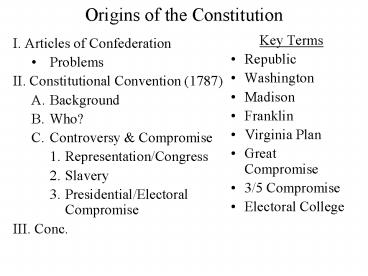Origins of the Constitution PowerPoint PPT Presentation
Title: Origins of the Constitution
1
Origins of the Constitution
- Key Terms
- Republic
- Washington
- Madison
- Franklin
- Virginia Plan
- Great Compromise
- 3/5 Compromise
- Electoral College
- I. Articles of Confederation
- Problems
- II. Constitutional Convention (1787)
- Background
- Who?
- Controversy Compromise
- Representation/Congress
- Slavery
- Presidential/Electoral Compromise
- III. Conc.
2
Some Problems With the Articles of Confederation
- Each state had one vote (regardless of its
population) - There were neither Executive nor Judicial
Branches - The national government did not have the power to
tax states could coin own money conduct
foreign policy
Articles of Confederation
3
Where did they meet?
Philadelphia Independence Hall
4
One Philosophy Prevailed
Republic
- Eligible citizens elect representatives who make
decisions establish policies for them
5
Who was at the Constitutional Convention?
George Washington
Washington presided over the Convention as its
chairman
6
Who was at the Constitutional Convention?
James Madison
Ben Franklin
7
Who was NOT at the Constitutional Convention?
Thomas Jefferson
Jefferson was the US Ambassador to France
8
Which individual had the greatest impact on the
Constitution?
- James Madison
9
Controversy Representation in CongressVirginia
Plan (Madison)
- Eliminate the Articles of Confederation
- Separate the National Government into three
branches Legislative (most powerful), Executive
Judicial
- Representation in the Legislative Branch would be
determined entirely by a states population
James Madison
10
Separation of Powers(Madisons Virginia Plan)
Legislative (most powerful) Executive Judicial
The number of Reps for each state is based on states population
11
Solution Great Compromise
- Separate the Legislative Branch into two
sections - House of Representatives (based on population)
- Senate (two for each state)
Ben Franklin
12
Solution Great Compromise(Franklin)
Legislative Executive Judicial
House of Representatives Based on population
Senate Two for each state
13
Controversy How to Count Slaves?
- Solution 3/5 Compromise
- One slave is equal to 3/5 of a person when
determining a states population
Torture Mask
14
Controversy Chief Executive
Legislative Executive ???? Judicial
House of Representatives ?????????????
Senate ?????????????
15
Controversy Chief Executive
Legislative Executive (President) Judicial
House of Representatives How to choose? Electoral College
Senate How to choose? Electoral College
16
How The Electoral College Works
Two Key Concepts
- In order to win a Presidential election a
candidate must win a majority of electoral votes
(270). - The candidate who wins the most popular votes in
a state wins ALL of that states pledged
electoral votes.
17
The Electoral College The States(Michigan as
an example)
MICHIGANS ELECTORAL VOTES
15 Members of the US House of Reps
2 _ US Senators
17 Electoral Votes
18
Distribution of Electoral Votes
STATE 1992-2002 2002-2012
Alabama 9 9
Alaska 3 3
Arizona 8 10
Arkansas 6 6
California 54 55
Colorado 8 9
Connecticut 8 8
Delaware 3 3
WA DC 3 3
Florida 25 27
Georgia 13 15
Hawaii 4 4
Idaho 4 4
STATE 1992-2002 2002-2012
Illinois 22 21
Indiana 12 11
Iowa 7 7
Kansas 6 6
Kentucky 8 8
Louisiana 9 9
Maine 4 4
Maryland 10 10
Massachusetts 12 12
Michigan 18 17
Minnesota 10 10
Mississippi 7 6
19
Distribution of Electoral Votes
STATE 1992-2002 2002-2012
Missouri 11 11
Montana 3 3
Nebraska 5 5
Nevada 4 5
New Hampshire 4 4
New Jersey 15 15
New Mexico 5 5
New York 33 31
North Carolina 14 15
North Dakota 3 3
Ohio 21 20
Oklahoma 8 7
Oregon 7 7
STATE 1992-2002 2002-2012
Pennsylvania 23 21
Rhode Island 4 4
South Carolina 8 8
South Dakota 3 3
Tennessee 11 11
Texas 32 34
Utah 5 5
Vermont 3 3
Virginia 13 13
Washington 11 11
West Virginia 5 5
Wisconsin 11 10
Wyoming 3 3
20
Electoral CollegeMichigan and the Presidential
Election of 2008
Candidate Popular Vote
Obama 57
McCain 41
Others 1
So, Barack Obama received ALL 17 of Michigans
pledged electoral votes.
21
Presidential Election Results
2008 Election 2008 Election 2008 Election
Candidate Electoral Vote Popular Vote
Obama 365 52.9
McCain 173 45.7
Others 0 1
Voter turn-out was VERY high about 136 million
64 of
eligible voters
22
Other Presidential Election Results
2000 Election 2000 Election 2000 Election
Candidate Electoral Vote Popular Vote
Bush 271 48
Gore 267 48.5
Others 0 3.5
Gore received about 500,000 more popular votes.
23
Other Presidential Election Results
1860 Election (156 Majority) 1860 Election (156 Majority) 1860 Election (156 Majority)
Candidate Electoral Vote Popular Vote
Abraham Lincoln 180 39.9
Stephen Douglas 12 29.5
John Breckenridge 72 18.1
24
Electoral College
If no candidate wins a majority of the Electoral
Votes, then
- The US House of Representatives chooses the next
President among the top three finishers
- The US Senate chooses the next Vice President
among the top two finishers for VP
25
Origins of the Constitution
- Key Terms
- Republic
- Washington
- Madison
- Franklin
- Virginia Plan
- Great Compromise
- 3/5 Compromise
- Electoral College
- I. Articles of Confederation
- Problems
- II. Constitutional Convention (1787)
- Background
- Who?
- Controversy Compromise
- Representation/Congress
- Slavery
- Presidential/Electoral Compromise
- III. Conc.

